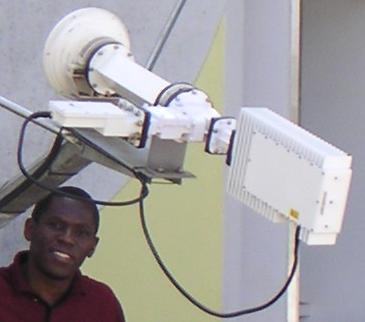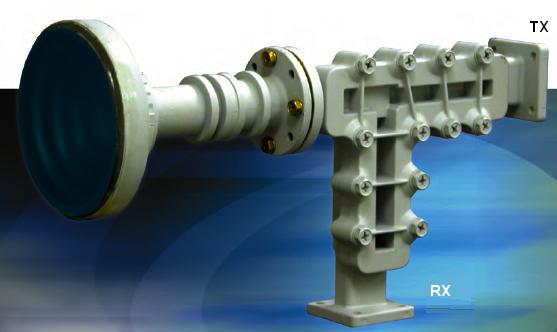A feed horn, comprising a circular waveguide flange, with circular hole, a corrugated flare section and a circular window aperture, allows all signals through, whether they are linear, circular polarisation, single polarisation or dual polarisation.
The feed horn flange may be connected to a variety of devices.

For a circular polarisation satellite system a polariser may be connected. This is a straight tube, square or circular in cross-section, with rows of ridges or pins along two sides, with their orientation at 45 to the plane of linear polarisation at the back end.
An OMT (orthomode transducer) may be connected, either to the back end of the polariser or direct to the feed horn, in the case of a linear polarisation system.
The OMT will separate the two linear polarisations, each into its own single waveguide. The bandwidth of these two waveguides may be the same (e.g. wideband 10.7-14.5 GHz) or the two waveguides may be different, with one for the transmit band and one for the receive band. Band-pass and band-stop filters may be included to emphasise one waveguide for transmit and one for receive.

VSAT antennas typically have an OMT with filters so that you transmit on one polarisation and receive on the other. This would be called a two port, cross polarisation feed.
In hub antennas, at teleports, the OMT may split into two wideband waveguides. Diplexer filters (tx and rx bands) may then be added to each waveguide so as to provide two transmit ports and two receive ports.

This rare arrangement shows a feed horn connected to a filter-diplexer. The whole arrangement works on a SINGLE polarisation, and transmits and receives on the same polarisation.

This adaptor plate allows you to connect a plain rectangular waveguide direct to the circular hole of the feed horn. This would be used when you want to connect an LNB (with a rectangular input waveguide) directly to the feed horn. The FRONT end goes to the LNB, the BACK end (with circular O ring slot) goes to the feed.

C band circular : Normal Cross-Pol configuration with OMT.

C band circular: Rare co-pol operation
In a few cases you use the same polarisation for transmit and receive. This is called co-pol operation. In this case you do not have an OMT, you have a diplexer instead which splits out two waveguides, both on the same polarisation. Filters are used to split the 4 and 6 GHz bands into the different waveguides.
Read more:
https://www.satsig.net/pointing/circular-polarisation-set-up.htmBest regards, Eric.









